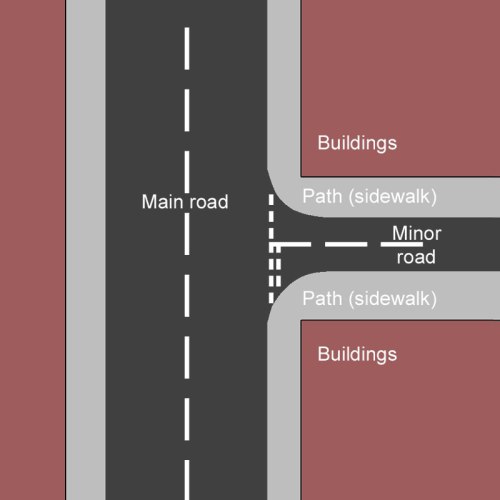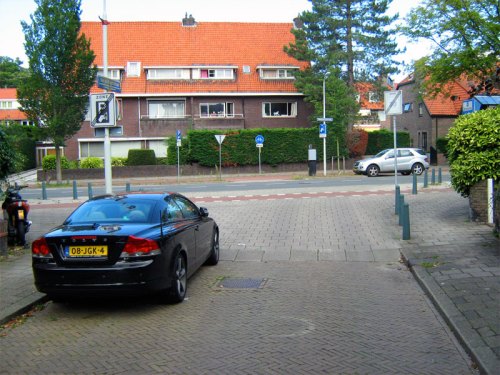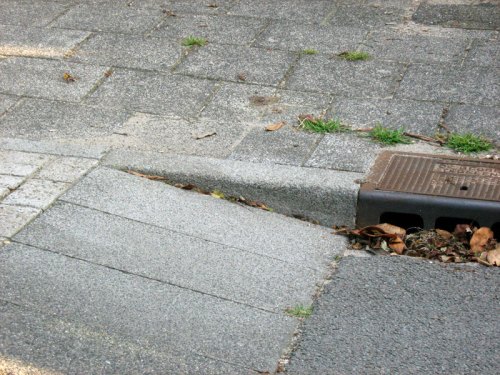It seems to me that one of the keys to successful cycling infrastructure is getting the detail right. Not everything has to be a massive gesture or huge engineering. Among the many things which impressed me on my recent visit to the Netherlands is how minor junctions are often handled.
In most countries, the tarmac on the road connects to the tarmac on all the other roads without a gap. If you live on the UK mainland, the tarmac on the road outside your front door is joined to the tarmac outside my front door without a break. It’s quite a feat when you think about it! We’re all connected by roads.
The footpath outside your front door, however, probably only circles the block of buildings in which you live. To get to the next path, you have to cross over part of the uninterrupted network of tarmac which covers the land.
This is so innate, so built-in to our way of thinking, that it goes unquestioned. Of course the roads are connected, or you can’t drive from one to the other! But it doesn’t have to be this way, as I discovered on the first night of a recent trip to the Netherlands. It’s such a small thing, such a simple thing that it’s hardly worthy of the word ‘engineering’ and yet the subliminal message it sends to road users is massive.
(This might well have been covered already by David Hembrow – it seems that most Dutch road innovations have! – but I can’t find it if it has.)
First, some diagrams. Here’s how we treat junctions in the UK:

I’m not an expert diagram-maker, but I think you’ll all recognise this as a standard UK road junction.
And here’s how we discovered similar junctions to be in the Netherlands:

A diagram of the kind of thing we saw in the Netherlands. Again, it’s simplified and not to scale, etc., but it gives you an idea of what I’m talking about.
And here’s some photos of what I call “continuous path”, firstly from a bike rider’s point of view:

There’s little doubt who has right of way from this point of view. The white squares make riders aware that there’s a potential hazard at that section.
And from the point of view of a driver or rider on the minor road:

To a driver leaving the minor road, it’s clear that they do not have priority here, as they have to drive up a ramp and over the cycle- and foot-paths to access the main road.
It’s not entirely clear from that photo, but leaving or joining the side road means driving up a ramp, over the path and back down again. Here’s a close-up of one:

It slows cars down, and subconsciously tells drivers that they are no longer on the road, but crossing a footpath.
I didn’t get a photo from the view a driver on the main road would have, but you can have a look for yourself on Google StreetView here. Here’s a photo of a similar junction at a different location, where again it’s clear that priority lies with people on the cycle path or footpath:

A different location, view from the road. It’s clear that you can’t just sweep around the corner like in the UK.
I think the design here has a psychological effect, and the clues are all on the floor. Having to drive up a ramp onto the level of the path, and the path surface looking and feeling different to the road surface and continuing across the junction, makes it clear that people walking and riding here have priority and that a motor vehicle is a temporary guest passing through a non-car domain.
Compare this with the British way of doing things. Firstly, at most junctions the road takes priority and the path is severed:

A very similar junction in London. Cars clearly have priority here, the wide corners of the junction mean that you barely have to slow when turning. (Image from Google StreetView, click photo to view on there.)
At some junctions in the UK there has been an attempt to implement the “continuous path” style by adding a hump, but as usual they seem to have got the detail wrong:
Clearly, the road continues around the junction here, despite the change in level. There’s tactile paving, “look left” and “look right” markings, double yellow lines continue around the corner. Pedestrians stop for vehicles here, not the other way around. You can have a look for yourself here, and there’s plenty of other examples about.
Not every junction in the Netherlands has this type of “continuous path” but we found it to be common. It’s a great way to show priority, and to slow vehicles down. We never had any problems with this type of junction, vehicles would always wait for people on bikes or on foot to clear the junction before crossing.
Of course, in the UK, cars turning into a road should give way to pedestrians who are already crossing, but in practice this never happens. It’s another example of the perfect fantasy world populated with reasonable, logical automatons that the Highway Code is set in. In reality, the pedestrian either retreats or runs across the road so the turning vehicle doesn’t have to slow down or stop. The stakes are simply too high for pedestrians to enforce this rule, and most people I’ve asked have never even heard of it.
Implementing this kind of junction in the UK would be physically easy – there’s really nothing special going on here, engineering-wise. However, getting the DfT to approve such a simple measure could take years…*
Update, 22nd of August 2012
Mark Wagenbuur of BicycleDutch makes it clear in a comment what I didn’t in the article: that the break in the road also helps signal to drivers that they’re changing road type, from a faster road into a slow residential area.
And Paul James covered this type of junction on Pedestrianise London back in February. I knew I’d seen it somewhere before!
*Update, 25th August 2012
I’m wondering now if the DfT would even need to approve such a thing here in the UK. Surely there could be a short “pedestrian zone, except for access” at the end of a street, thereby creating the same effect within current UK regulations? Sure, it might be a bit sign-heavy (there would need to be ‘pedestrian zone starts’ and ‘pedestrian zone ends’ signs at each end) but still do-able I reckon.


 The Alternative Department for Transport is written by, and the personal opinion of,
The Alternative Department for Transport is written by, and the personal opinion of, 



The big problem here in the UK with this sort of infrastructure is, that the powers that be will never give priority to pedestrians first, cyclists second and motorised vehicles last. Motorised vehicles will always be put first.
The examples you give above would save a heck of a lot of lives and injuries. To give the weaker priority is logical.
I know that government thinking in the UK has been car-focussed since the 1950s, but I think these junctions could be an easy sell to residents of a street. They still retain access, but it slows traffic down, increasing safety. To me it also makes a street feel more owned and enclosed, rather than just another road. I wonder if it also helps discourage rat-running?
(All we’d need is to find a statistic showing that it increases house prices and neighbourhoods up and down the country would want it!)
I suspect that it would discourage rat running. Being forced to slow down both ends of a quieter road not only for pedestrians and cyclists, but once passed that hurdle they then have to slow down again to give way to the actual traffic on the main road, would give the impression that it’s actually quicker to stay on the main road rather than use a cut off. And as you say, it sort of gives a feeling that one is entering an area as a guest, rather than a right for cars.
But also, have you noticed how much cleaner and calmer it makes the whole area look? Using road surfaces and road markings instead of signs gives a far less cluttered affect. I think entrances like this could also possibly encourage the slowing down in 20pmh roads as well and possibly then be able to do away with road humps.
One thing I hate to see is the road humps to slow down traffic. I think they make a road look ….. (trying to think of a word here)….. Scruffy? – They are also very uncomfortable to cycle over on a trike. I have to pull out more into the centre to make sure both my back wheels go over at the same height or end up tilted over at a very wobbly angle. I wouldn’t want to be pulling a child carrier behind a bike.
I have no idea if the Dutch use road humps. I must investigate that one.
They do, actually! I’ve got a post planned on those, too. In a nutshell they have them but they’re very different. They have the deliciously Dutch name of “drempel”.
Something that BicycleDutch can perhaps confirm, but I get the distinct impression from David Hembrow’s blog that rat-running is next to impossible in the Netherlands, because most residential streets are made into dead ends, at least for cars.
Rat-running must be one of the most depressing things about living in the UK, to my mind at least.
Not dead end per se, but loop holes. Try to get through, and you’ll end up a bit further back from where you were. Take the example of a through road with, behind blocks of housing, a parallel road. The parallel road keeps spilling out on the main road, but the direction of driving in it keeps changing: one stretch driving north for example, the next one south, next bit north again, all combined with the driving direction of the cross streets. Basically you end up with a lot of “U” bits, one clockwise, next one counterclockwise, etc, making it impossible to use the long parallel road as a means for ratrunning, but access is always possible. A very cheap way of lowering traffic movement. Add a counterflow bike lane and there you go, excellent bicycle provisions on the cheap. But then, even better if combined with the above described gateways.
What you have not mentioned, or maybe it was not so obvious, is that there is not only a difference in the type of these roads but also in the speed limit. The “main” road is a collector road which is there to bring traffic to the residential streets. The collector road is a through street and has a 50km/h (31mph) speed limit. Because of that – what the Dutch consider – higher speed and the higher volume of traffic it has separated cycle paths. The smaller street is a purely residential street with a speed limit of 30km/h (18mph) and this physical barrier between the types is also there to signal that to drivers. Next to the signs that are also there. (You can see a round sign with 30 [km/h] for traffic entering and a rectangular gray sign with a slash that says end of the 30km/h zone for traffic leaving the minor street on the different pictures.) Most measurements in Dutch street design have more than one purpose. So not only a safe way for cyclists and pedestrians to cross the minor street, and a way to indicate who has the right of way, but also a great way to signal to drivers they are entering a different type of road with different speed limit and where they will find bicycles in their path. This categorisation of streets is what the ‘sustainable safety‘ policy regulates.
Thanks for that, well spotted! I had meant to make it a bit clearer than I did. What I call a “main road” is the distributor/collector road, and the “minor road” would be a residential street with a lower speed limit. Thanks for the additional info!
Oh and the hierarchy difference in the roads is also the reason that this is not done at every junction. Where two through streets or two residential streets meet (in other words ‘equal’ streets) you will not see this design.
Great post. I wrote about Dutch gateways earlier in the year, but I feel you get the message across much more succinctly, you’re totally right about the devil being in the details and about how simple the Dutch street design practices would be to duplicate in the UK.
http://pedestrianiselondon.tumblr.com/post/18314850805/gateways
Ah, I knew I’d seen something about this somewhere! I’ll add a link to your post.
I see that the junction of College Road which is in your post has some attempt at the Dutch-style gateway – with the yellow colour of the path continuing across, and the raising of the road – yet it continues to give turning vehicles priority over pedestrians. So I wonder, what is it for?!
about that last picture… I was wondering ‘why would they write look “left and right” in such an odd way, drivers could never read that, even more so as they have to look out for pedestrians and cyclists and other cars in the meantime…’ but then it slowly started to get to me that this was meant for the pedestrians! You see, we get used so quickly over here to peds and bikes having priority, that it is hard to turn around on seeing how things work in the UK. Btw, to Dutch eyes British roads do have a lot of crooked lines and texts on the asphalt, though, making the streetscape look a bit cluttered. Though I’ve read comments saying just that about Dutch roads, so perhaps it’s just what one’s used to…
Nice write up. I made this vid a while back in Copenhagen showing exactly your point here. http://www.youtube.com/watch?v=QcnmLU1ClTo It just looks so simple. Really small change to layouts, but would have a huge impact on road behavior (possibly)
Suppose one would get a municipality in the UK to redesign a complete main street and the gateways of all the crossroads, and get them to incorporate one or two bike paths like in the photos. In the Netherlands, such a situation would be combined with renewing all pipes, cables and gas ducts, so the street won’t have to be dug up next year all over. It takes a lot of planning, but in the end doing it right will be cheaper than doing it twice half-assed.
Mark Wagenbuur has made some nice videos:
http://bicycledutch.wordpress.com/2012/07/12/before-and-after-s-hertogenbosch-3/
Pingback: Some cycle tracks and junctions in Amsterdam | As Easy As Riding A Bike
I’m sure it also helps that Dutch drivers cannot so easily get away with bumping into cyclists. A big reason British planners are reluctant to give a sidepath priority over turning traffic is they don’t believe drivers will give way and that some of the blame for resulting accidents will be laid at their door.
But you can push for this as well as pushing for the right infrastructure. Why do you consistently focus on every aspect except the big one? Bike track priority does exist in UK law, it’s perfectly feasible. Next excuse please!
In the UK pedestrians do actually in many instances already have priority.
1) Once a pedestrian has a foot on the road they instantly have priority. Therefore unless one reaches the side road as a pedestrian and a car is already waiting to pull out in front of them the pedestrian does have priority.
2) The Blind have priority.
3) Disabled have priority.
4) Anyone pushing a pram or a buggy has priority.
Priority meaning that vehicles “have” to stop and give way.
Unfortunately not many drivers actually know this. I have had many a discussion with a motorist regarding this subject. Goodness knows who actually taught half of our motorists to drive.
We will not get safe roads until our infrastructure is changed to force laws to be obeyed.
By continuing the pavement across the side road it’s enforcing the fact that pedestrians do have priority. It gives a clear message. At the moment our infrastructure gives the message that vehicles always have priority on the side roads, which simply isn’t true.
Another interesting post. Cyclists aside for a minute, but there are loads of accesses like this where a simple dropped kerb gets cars over the footway into private estate roads, parking courts etc. I cannot think that there is a legal impediment to doing this at a road junction (in a sensible place) although I might be tempted to use tactile paving. Preventing parking might be the issue here and yellow
lines might be needed. Of course, then a segregated cycle track can be added, but from memory, it needs to be on a speed table. Perhaps local authority needs to just do a Dutch one, monitor it and record the design process and decision as the risk of being sued for innovation is so remote, you would not believe…
Pingback: Cycleway design in Berlin and beyond | The Alternative Department for Transport
Pingback: Visual Priority | The Alternative Department for Transport
Pingback: Linen Quarter Consultation – Analisys II – nicycles
Pingback: Another visit to Leeds’ unfinished “Cycle Superhighway” with no end in sight | The Alternative Department for Transport
Pingback: Middlepath shows what’s coming for cycling in Belfast – NI Cycles